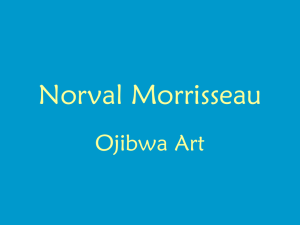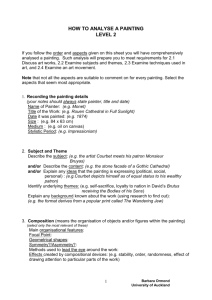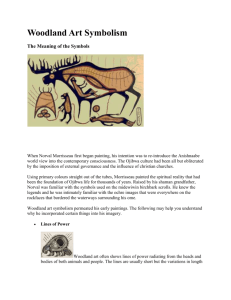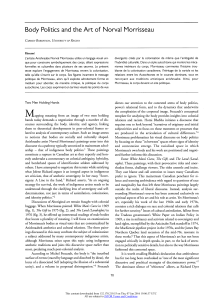Eastern Woodland Project
advertisement
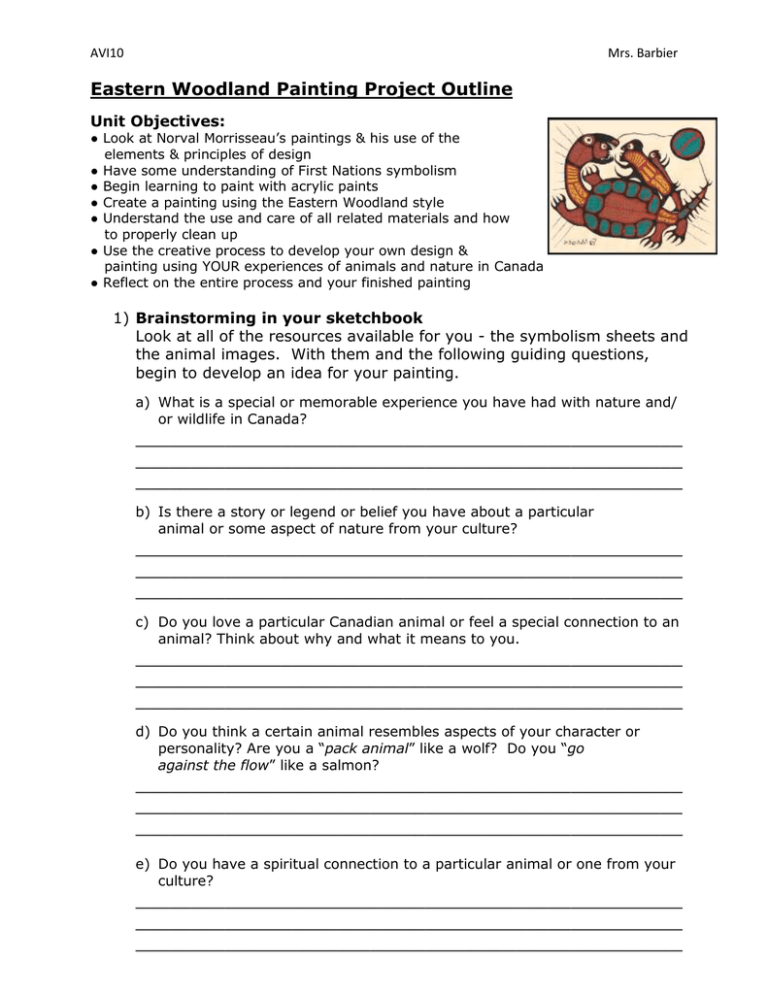
AVI10 Mrs. Barbier Eastern Woodland Painting Project Outline Unit Objectives: ● Look at Norval Morrisseau’s paintings & his use of the elements & principles of design ● Have some understanding of First Nations symbolism ● Begin learning to paint with acrylic paints ● Create a painting using the Eastern Woodland style ● Understand the use and care of all related materials and how to properly clean up ● Use the creative process to develop your own design & painting using YOUR experiences of animals and nature in Canada ● Reflect on the entire process and your finished painting 1) Brainstorming in your sketchbook Look at all of the resources available for you - the symbolism sheets and the animal images. With them and the following guiding questions, begin to develop an idea for your painting. a) What is a special or memorable experience you have had with nature and/ or wildlife in Canada? _________________________________________________ _________________________________________________ _________________________________________________ b) Is there a story or legend or belief you have about a particular animal or some aspect of nature from your culture? _________________________________________________ _________________________________________________ _________________________________________________ c) Do you love a particular Canadian animal or feel a special connection to an animal? Think about why and what it means to you. _________________________________________________ _________________________________________________ _________________________________________________ d) Do you think a certain animal resembles aspects of your character or personality? Are you a “pack animal” like a wolf? Do you “go against the flow” like a salmon? _________________________________________________ _________________________________________________ _________________________________________________ e) Do you have a spiritual connection to a particular animal or one from your culture? _________________________________________________ _________________________________________________ _________________________________________________ AVI10 Mrs. Barbier 2) Research your animals and make sketches Spend time researching the animals you have chosen to paint. Look for photographs of your animals in positions and taken from angles that are suitable to your design. Sketch from the screen into your sketchbook. Don't make the drawings too small - fill the page and use as many pages as you can. Accuracy matters: Proportion, shape, details... Make your drawings as accurate as you can - remember contour drawing techniques to tap into your right-brain to increase your observation and decrease your generalisations so your sketches become more life-like. Record the site where you found the picture so you can go back and look at it if you need to and/or send it to your email account. Sites: Type in canadian wildlife animals photographs, click images. Also try native canadian species, travel.nationalgeographic.com/travel/canada/animals-photos and by typing in the animal by name. 3) Choosing the best design Choose the design that you like best. Go through the magazines in the classroom to find colours for your painting. Cut out a piece of the colour and glue it onto your picture. You will try to recreate that colour later. 4) Starting your painting Draw your design onto your good copy using the non-photo blue pencil. Be sure to include a minimum of four (4) different characteristics employed by Norval Morrisseau (i.e. communication line, divided circle, flat colour, large eyes, x-ray, etc.). 5) Painting Begin to paint your good copy. You can only use the primary colours plus black and white. This means you will need to mix your colours. 5) Reflection Once you have finished the painting you are going to complete the Reflection page. AVI10 Mrs. Barbier Eastern Woodland Art Symbolism The Meaning of the Symbols When Norval Morrisseau first began painting, his intention was to re-introduce the Anishnaabe world view into the contemporary consciousness. The Ojibwa culture had been all but obliterated by the imposition of external governance and the influence of Christian churches. Using primary colours straight out of the tubes, Morrisseau painted the spiritual reality that had been the foundation of Ojibwa life for thousands of years. Raised by his shaman grandfather, Norval was familiar with the symbols used on the Midewiwin birch bark scrolls. He knew the legends and he was intimately familiar with the ochre images that were everywhere on the rock faces that bordered the waterways surrounding his home. Woodland art symbolism permeated his early paintings. The following may help you understand why he incorporated certain things into his imagery. Lines of Power Woodland art often shows lines of power radiating from the heads and bodies of both animals and people. The lines are usually short but the variations in length and intensity indicate the quality of power. The lines can both transmit and receive information. Lines of Communication Woodland artists often portray animals and people joined with flowing lines which indicate relationships which reflect the artist's understanding of the nature of the interdependence between the two beings. This is a recent painting by Goyce Kakegamic depicting the legend of Red Lake. AVI10 Mrs. Barbier Lines of Prophecy Some powerful creatures may have narrow ivy-like lines spewing from their mouths which indicate more than simple speech - they indicate prophecy, particularly in association with shaman imagery. A good example is this painting by Norval Morrisseau showing a shaman making direct communication with the universal life force. Lines of Movement Very short lines, clustered near an organ like a heart as in this example, indicate movement and an active attempt at communication with the viewer. The lines are particularly significant surrounding shaking tent imagery. The Divided Circle A circle divided in half, connected with the main image by lines of communication is an especially meaningful symbol used by woodland artists. The divided circle represents dualities present in the world - good and evil, day and night, sky and earth, honest and dishonest, function and dysfunction for example. X-Ray Decoration The term would have been meaningless to prehistoric woodland artists, but nowadays the concept of an x-ray view aptly describes the way woodland artists depict inner structures of people and animals. They are representations of inner spiritual life. Colour In prehistoric times the only significant colour used was red ochre as in this ancient image of mishpashu (a water spirit) on a cliff overlooking Lake Superior. In 1937 the image had been covered over with dark green oil based house paint by the twelve year old daughter of the local Indian agent. More than seventy years later the green paint has been destroyed by the elements but the original ochre illustration still stands proud. AVI10 Mrs. Barbier Student Reflection – Analyzing Your Learning Name: ______________________ Project: Eastern Woodland Painting Reviewing and analyzing your work is an important part of the creative process. Review can also help you set goals for improving your work in the future. Take a few minutes now to reflect upon this project. Fill in the table below by circling the level that best reflects your performance. Then answer the questions in Section II and Section III. Section I Very weak R 1 2 Outstanding 3 4 1 2 3 4 1 2 3 4 1 1 2 2 3 3 4 4 1 1 2 2 3 3 4 4 My effort My willingness to R follow the creative process My ability to solve problems by R myself My creativity R My learning and skill R development My finished product R My participation in R clean up Section II: Think About Your Process 1. What is your favourite part of the painting? ____________________________________________________ ____________________________________________________ ____________________________________________________ 2. What was the most challenging part of this project? Why was this particular part difficult? ____________________________________________________ ____________________________________________________ ____________________________________________________ ____________________________________________________ 3. How did you deal with this challenge? ____________________________________________________ ____________________________________________________ ____________________________________________________ ____________________________________________________ 4. If you could start this project again, what are two things would you do differently? Briefly explain why. ____________________________________________________ ____________________________________________________ ____________________________________________________ ____________________________________________________ AVI10 Mrs. Barbier Section III: Analyze Your Artwork 1. What are the three (3) most important elements of design (line, colour, shape/form, texture, value and space) used in your artwork? Briefly explain why each is so important in your design. ____________________________________________________ ____________________________________________________ ____________________________________________________ ____________________________________________________ ____________________________________________________ ____________________________________________________ 2. What are the two (2) most important principles of design (emphasis, movement, rhythm, pattern, balance, proportion, contrast and unity) used in your artwork? Describe how the elements are used to create each principle. Then, briefly describe what that principle does or how it works in your composition. ____________________________________________________ ____________________________________________________ ____________________________________________________ ____________________________________________________ ____________________________________________________ ____________________________________________________ Section IV: Interpreting Your Artwork 3. What animal(s) did you use in your painting? Explain what the animal represents and how it ties in to your life/personality. ____________________________________________________ ____________________________________________________ ____________________________________________________ ____________________________________________________ ____________________________________________________ ____________________________________________________ ____________________________________________________ 4. List the different characteristics you employed to create your Eastern Woodland Painting. Where have you employed each of the techniques and why did you choose to incorporate the techniques in those specific areas? ____________________________________________________ ____________________________________________________ ____________________________________________________ ____________________________________________________ ____________________________________________________ ____________________________________________________ AVI10 Mrs. Barbier Deconstructing A Painting By Norval Morrisseau Elements Complementary colours -blue and orange (also red & green, but less) No values, flat colour Thick black contour lines; some details shown with thinner red lines Shapes: geometric and organic No texture Space: suggestion of sea and sky, but the bird is still floating in the space Principles of Design Balance: symmetrical Emphasis: on the yellow eye Rhythm: feather-shapes of the wings Movement: created by the communication lines and the rhythm of the wings Contrast: Black vs. colour, Complementary colours, Organic vs. geometric, Light vs. dark, Thin vs. thick Pattern: designs on the wings, divided circles Unity: repetition of blue colours, the red lines, and the black lines; the symmetry; the same painting style; the black frame around the painting Symbols Eye = the shaman Divided circles = sea vs. sky duality Lines of communication = everything is connected Line of power from the bird’s head = bird is more powerful in air than in the water (?) X-ray view of bird = ?
